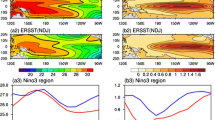Abstract
With the Zebiak–Cane model, the relationship between the optimal precursors (OPR) for triggering the El Niño/Southern Oscillation (ENSO) events and the optimally growing initial errors (OGE) to the uncertainty in El Niño predictions is investigated using an approach based on the conditional nonlinear optimal perturbation. The computed OPR for El Niño events possesses sea surface temperature anomalies (SSTA) dipole over the equatorial central and eastern Pacific, plus positive thermocline depth anomalies in the entire equatorial Pacific. Based on the El Niño events triggered by the obtained OPRs, the OGE which cause the largest prediction errors are computed. It is found that the OPR and OGE share great similarities in terms of localization and spatial structure of the SSTA dipole pattern over the central and eastern Pacific and the relatively uniform thermocline depth anomalies in the equatorial Pacific. The resemblances are possibly caused by the same mechanism of the Bjerknes positive feedback. It implies that if additional observation instruments are deployed to the targeted observations with limited coverage, they should preferentially be deployed in the equatorial central and eastern Pacific, which has been determined as the sensitive area for ENSO prediction, to better detect the early signals for ENSO events and reduce the initial errors so as to improve the forecast skill.






Similar content being viewed by others
References
Birgin EG, Martinez JM, Raydan M (2000) Nonmonotone spectral projected gradient methods on convex sets, SIAM J. Control Optim 10:1196–1211
Blumenthal MB (1991) Predictability of a coupled ocean–atmosphere model. J Climate 4:766–784
Buizza R, Palmer TN (1995) The singular-vector structure of the atmospheric general circulation. J Atmos Sci 52:1434–1456
Chen YQ, Battisti DS, Palmer RN, Barsugli J, Sarachik E (1997) A study of the predictability of tropical Pacific SST in a coupled atmosphere/ocean model using singular vector analysis. Mon Wea Rev 125:831–845
Duan WS, Mu M, Wang B (2004) Conditional nonlinear optimal perturbations as the optimal precursors for El Niño-Southern Oscillation events. J Geophys Res 109:D23105. doi:10.1029/2004JD004756
Duan W, Wei C (2012) The ‘spring predictability barrier’ for ENSO predictions and its possible mechanism: results from a fully coupled model. Int J Climatol. doi:10.1002/joc.3513
Langland RH (2005) Issues in targeted observing. QJR Meteorol Soc 131:3409–3425. doi:10.1256/qj.05.130
Lorenz EN (1965) A study of the predictability of a 28-variable atmospheric model. Tellus 17:321–333
Molteni F, Buizza R, Palmer TN, Petroliagis T (1996) The new ECMWF ensemble prediction system: methodology and validation. QJR Meteorol Soc 122:73–119
Moore AM, Kleeman R (1996) The dynamics of error growth and predictability in a coupled model of ENSO. QJR Meteorol Soc 122:1405–1446
Moore AM, Kleeman R (1997a) The singular vectors of a coupled ocean–atmosphere model of ENSO, Part I: thermodynamics, energetics and error growth. QJR Met Soc 123:953–981
Moore AM, Kleeman R (1997b) The singular vectors of a coupled ocean–atmosphere model of ENSO, Part II: sensitivity studies and dynamical interpretation. QJR Met Soc 123:983–1006
Moore AM, Vialard J, Weaver A, Anderson DLT, Kleeman R, Johnson JR (2003) The role of atmospheric dynamics and nonnormality in controlling optimal perturbation growth in coupled models of ENSO. J Clim 16:951–968
Morss RE, Battisti DS (2004a) Evaluating observing requirements for ENSO prediction: experiments with an intermediate coupled model. J Climate 17:3057–3073
Morss RE, Battisti DS (2004b) Designing efficient observing networks for ENSO prediction. J Climate 17:3074–3089
Mu M, Duan WS (2003) A new approach to studying ENSO predictability: conditional nonlinear optimal perturbation. Chin Sci Bull 48:1045–1047
Mu M, Duan WS, Wang B (2003) Conditional nonlinear optimal perturbation and its applications. Nonlinear Processes Geophys 10:493–501
Mu M, Zhang ZY (2006) Conditional nonlinear optimal perturbation of a barotropic model. J Atmos Sci 63:1587–1604
Mu M, Xu H, Duan WS (2007) A kind of initial errors related to ‘spring predictability barrier’ for El Niño events in Zebiak–Cane model. Geophys Res Lett 34:L03709. doi:10.1029/2006GL027412
Mureau R, Molteni F, Palmer TN (1993) Ensemble prediction using dynamically-conditioned perturbations. QJR Meteorol Soc 119:299–323
Philander SGH (1990) El Niño, La Niña, and the southern oscillation. Academic Press, San Diego, p 289
Thompson CJ (1998) Initial conditions for optimal growth in a coupled ocean–atmospheric model of ENSO. J Atmos Sci 55:537–557
Xu H (2006) Studies of predictability problems for Zebiak–Cane ENSO model. PhD Thesis, Beijing, Institute of Atmospheric Physics
Xu H, Duan WS (2008) What kind of initial errors cause the severest prediction uncertainty of El Niño in Zebiak–Cane model. Adv Atmos Sci 25:577–584
Xue Y, Cane MA, Zebiak SE, Blumenthal MB (1994) On the prediction of ENSO: a study with a low-order Markov model. Tellus 46A:512–528
Xue Y, Cane MA, Zebiak SE (1997a) Predictability of a coupled model of ENSO using singular vector analysis. Part I: optimal growth in seasonal background and ENSO cycles. Mon Wea Rev 125:2043–2056
Xue Y, Cane MA, Zebiak SE (1997b) Predictability of a coupled model of ENSO using singular vector analysis. Part II: optimal growth and forecast skill. Mon Wea Rev 125:2057–2073
Yu Y, Duan WS, Mu M (2009) Dynamics of nonlinear error growth and season-dependent predictability of El Niño events in the Zebiak–Cane model. QJR Meteorol Soc 135:2146–2160
Yu Y, Mu M, Duan W, Gong T (2012) Contribution of the location and spatial pattern of initial error to uncertainties in El Niño predictions. J Geophys Res. doi:10.1029/2011JC007758
Zebiak SE, Cane A (1987) A model El Niño–southern oscillation. Mon Weather Rev 115:2262–2278
Acknowledgments
This work was jointly sponsored by the National Basic Research Program of China (nos. 2012CB417404, 2012CB417403, 2010CB950402), the National Nature Scientific Foundation of China (no. 41230420), the Knowledge Innovation Program of the Chinese Academy of Sciences (no. KZCX2-EW-201), the National Nature Scientific Foundation of China (nos. 41006007), and the Basic Research Program of Qingdao Scientific and Technological Plan (111495jch).
Author information
Authors and Affiliations
Corresponding author
Rights and permissions
About this article
Cite this article
Mu, M., Yu, Y., Xu, H. et al. Similarities between optimal precursors for ENSO events and optimally growing initial errors in El Niño predictions. Theor Appl Climatol 115, 461–469 (2014). https://doi.org/10.1007/s00704-013-0909-x
Received:
Accepted:
Published:
Issue Date:
DOI: https://doi.org/10.1007/s00704-013-0909-x



